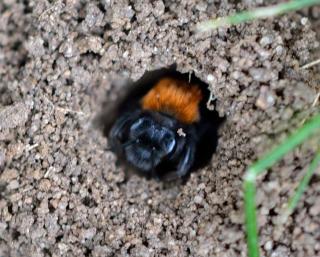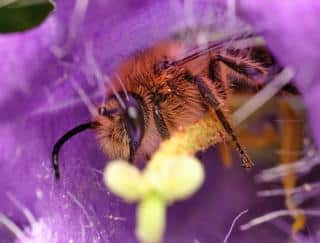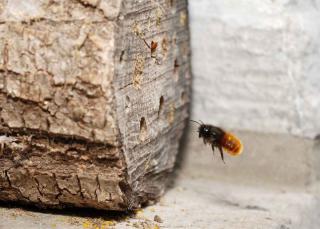

Mason bee, Osmia, solitary bee… all these names designate the same pollinating insect. And don’t be fooled by its tiny scale! It is indeed able to pollinate as many flowers as its more famous cousin, the common honeybee.
Read on to learn more about this little-known pollinating insect.
Read also:
Description
When we talk about the mason bee, it’s actually a catch-all name that encompasses a great many species with different characteristics. They do, though, have a few things in common:
Colors vary greatly depending on the type of bee. Here’s a short list of the main colors you’ll find:
No need for a hive for the “solitary bee”. As the name shows, it isn’t a gregarious insect (which the common honeybee, on the other hand, is). Most of the time, it lives alone in the burrows it digs out for itself underground.Some species take advantage of holes they find in dead wood to set up their nest.

Whether it’s an adult or still a larva, the carpenter bee feeds on pollen and nectar. Nonetheless, as with every species, different individual bees might have different diets:
 some of them are in fact only attracted to a single particular species of flowers;
some of them are in fact only attracted to a single particular species of flowers;On top of this, they won’t be active at the same time. From Spring to Fall, each species will be active and dormant over different periods. Since the larva can’t forage on their own, females prepare a chamber for them which they then fill up with a paste of nectar and pollen. There’s enough food for the larva to grow and turn into an adult, while staying safe from any predators on the outside.
The mason bee is a particularly hard-working pollinator, which needn’t fear comparison to its more famous relative, the common honeybee. It thus plays an essential role in parks and gardens. Thanks to this bee, flower diversity is preserved and encouraged, and crops are more productive wherever we expect harvests, such as orchards and vegetable patches.
Make your garden appealing and Osmia will appear on its own. Whether in the vegetable patch or in the orchard, you’ve got several options to try out. Best of course is to try them all at once! You’ll be sure to welcome a few at least of this excellent pollinator on your plot.
Since mason bees nest either in the ground or in holes it finds in old wood, it makes sense to give it a bit of both. That way it’s sure to find shelter!
 A great way to go forward is to set up nesting sites directly in the ground. For instance, rake up a mound of soil, and create a “cliff” on one side of the mound with a spade. Pull weeds out from around that area to help the bees find their way to it.
A great way to go forward is to set up nesting sites directly in the ground. For instance, rake up a mound of soil, and create a “cliff” on one side of the mound with a spade. Pull weeds out from around that area to help the bees find their way to it.The mason bee’s main food source is pollen and nectar. Grow flowers that have abundant amounts of both. Favor heirloom species, especially those with simple flowers (not double or semi-double blooms). Wildflowers are best. This is because many of the modern double-flowered or pompom-like flower varieties sold in stores have much less pollen. A few ideas:
Although it may be small, the mason bee is clearly a beneficial insect for the garden, and a great helper for the gardener! They complement honeybees in their tasks, a much needed help since numbers are dwindling across the entire planet.